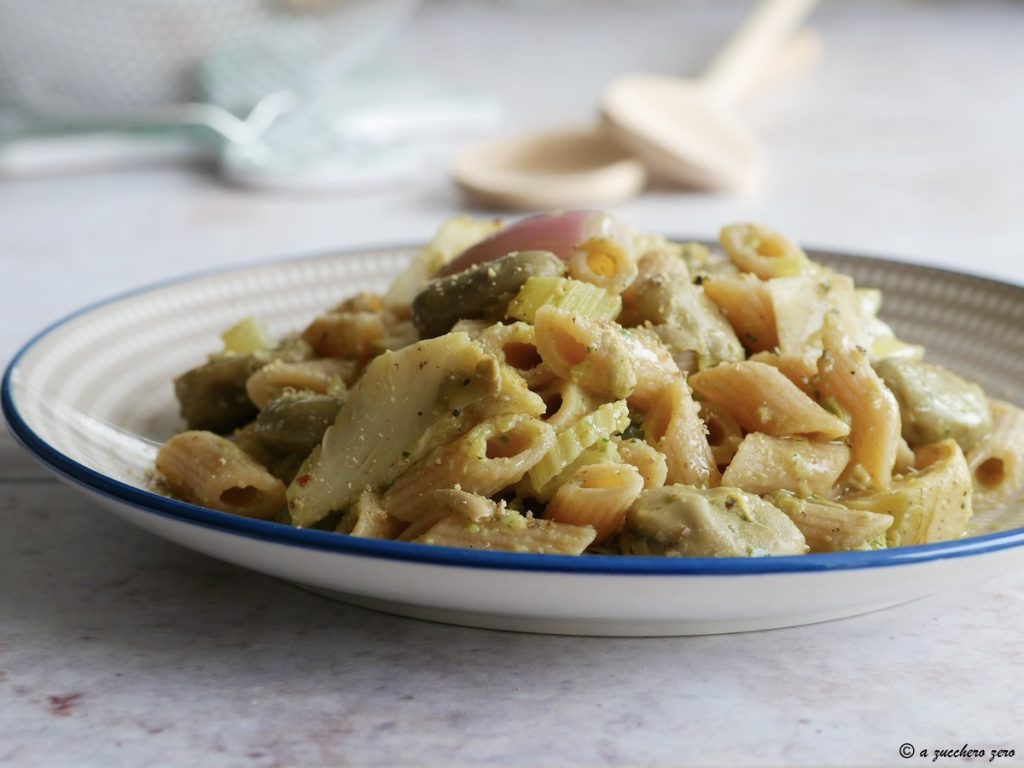The vignarola with artichokes and fava beans is a simple peasant dish to prepare.
The vignarola – from vignarolo: gardener – is a traditional farmer’s recipe that was typically prepared upon returning from the vineyards using the legumes and vegetables grown and harvested between the rows of vines.
It marked the transition from winter [last artichokes of the season] to spring [first peas and fava beans].
Due to the presence of legumes we do not consider it a side dish but a soup.
I used only green fava beans, but it can be prepared with green fava beans and green peas or even only with green peas.
FAVA BEANS AND DIABETES
– Can diabetics eat fava beans?
The glycemic index of fava beans [GI 40] is higher compared to other legumes and it increases with cooking.
In cases of hyperglycemia, prediabetes and diabetes cooked fava beans should be consumed in moderation [always according to your dietary plan, which includes them].
As Professor Enzo Bonora generally advises
In any case, in the presence of diabetes, it is essential to gain experience on the impact of this and all other foods on blood sugar. This means measuring it before and two hours after eating it. Preferably more than once for more reliable information. If the blood sugar increase is contained [under 50 mg] you can give a “green light” to that type of food. Otherwise, it’s better to avoid it.
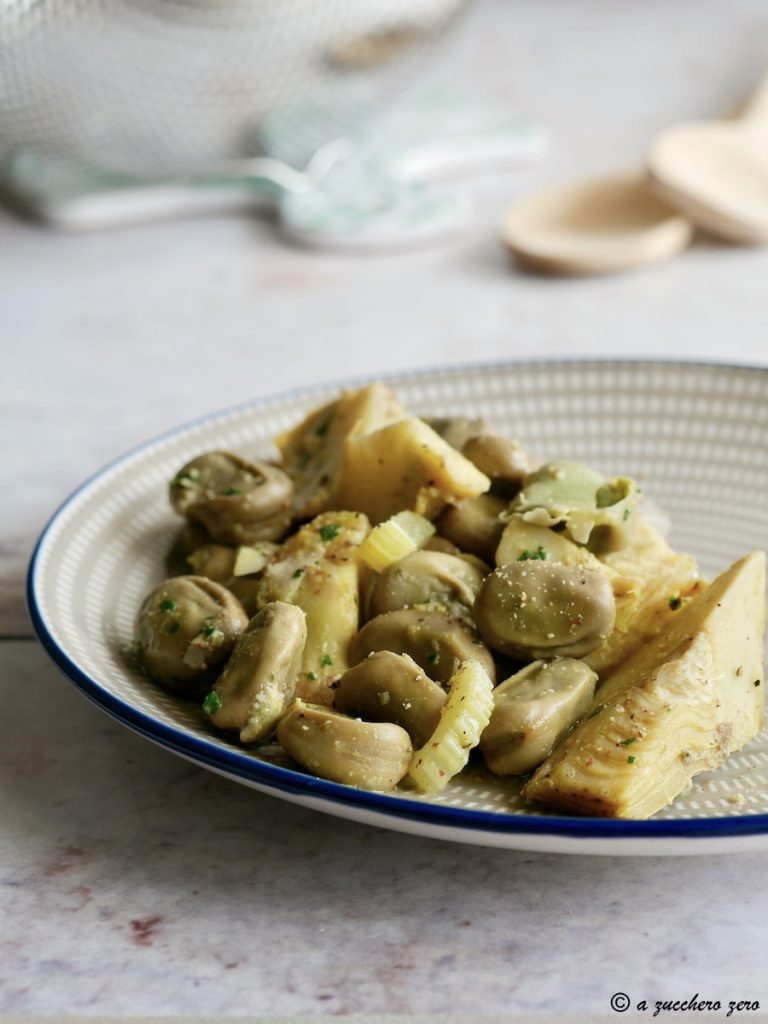
- Difficulty: Easy
- Cost: Economic
- Preparation time: 15 Minutes
- Portions: 2People
- Cooking methods: Stove
- Cuisine: Italian
Ingredients
Fresh Fava Beans Raw and Cooked Weight
From one kilogram of fresh fava beans [weight with pod] I obtained about 375 g of fresh fava beans [without pod].
- fresh fava beans (2 portions, weight according to dietary plan)
- as needed onion (or shallot)
- 1 pinch garlic powder
- 2 tbsp water (+ as needed)
- 1 vegetable bouillon cube (homemade)
- 1 sprig parsley
- 1 pinch salt
- 1 pinch mixed peppercorns (with grinder)
- 4 artichokes (or 9 oz frozen artichoke quarters)
- as needed shallot (or onion)
- as needed celery (stalks and leaves)
- as needed lemon juice
- 6.8 tbsp water
- 1 vegetable bouillon cube (homemade)
- 1 pinch salt
- 1 pinch mixed peppercorns (with grinder)
- as needed chopped parsley
- 1 drizzle extra virgin olive oil (raw)
Suggested Tools
- 1 Knife
- 1 Cutting Board
- 1 Sauté Pan
Preparation
The guidelines for healthy eating indicate the following standard portions:
• fresh, soaked, or canned legumes 5.3 oz;
• dried legumes 1.8 oz.
⇒ remember that the weights are personal.
Clean the Fresh Fava Beans
Extract the fresh fava beans from the pod.
“Pinch” the fava beans, meaning remove the stem, slightly exposing the top.
If you’re not adept at doing it with your fingers like grandmothers do, use a knife and cut off a small piece of the fava bean!
Rinse the fava beans under running water.Stewed Fava Beans or Braised Fava Beans
Pee the onion, remove the ends and rinse.
You can add it whole, halved, or chopped according to taste.In a sauté pan, heat a sprinkle of garlic powder.
Add the onion and let it wilt for a few seconds.
Add 2 tablespoons of water and wait for it to sizzle.
Pour the fava beans into the pan and sauté them.Add more water to cover the fava beans by a finger, a vegetable bouillon cube and the parsley.
Stew the fava beans for about 10 minutes and, if necessary, add more water.
Add the salt and grind the pepper.
Continue cooking for 30 to 60 minutes on low heat, making sure to:
• check the consistency of the fava beans;
• add more water if necessary;
• stir to prevent the fava beans from sticking to the bottom of the pan as they dry.The cooking time of fresh fava beans varies depending on:
• the size and freshness of the fava beans;
• the desired consistency.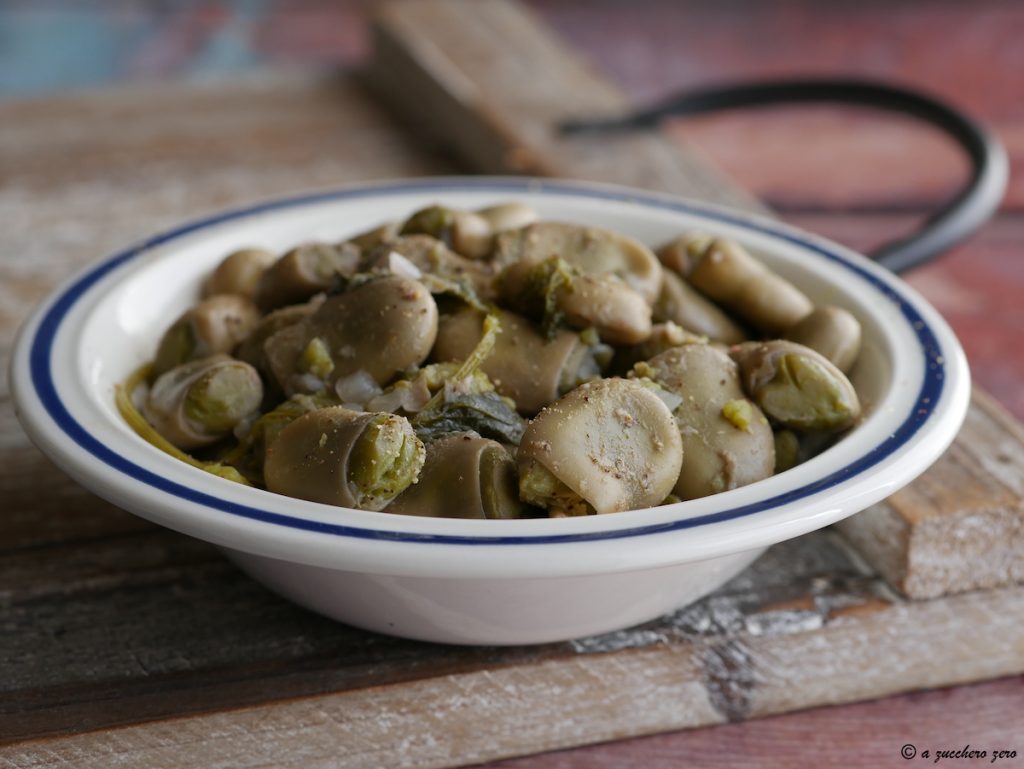
If using fresh artichokes, clean and blanch the artichokes following the procedure described in the how to clean and blanch artichokes tutorial.
Cut the artichokes into quarters.
I used frozen artichoke quarters.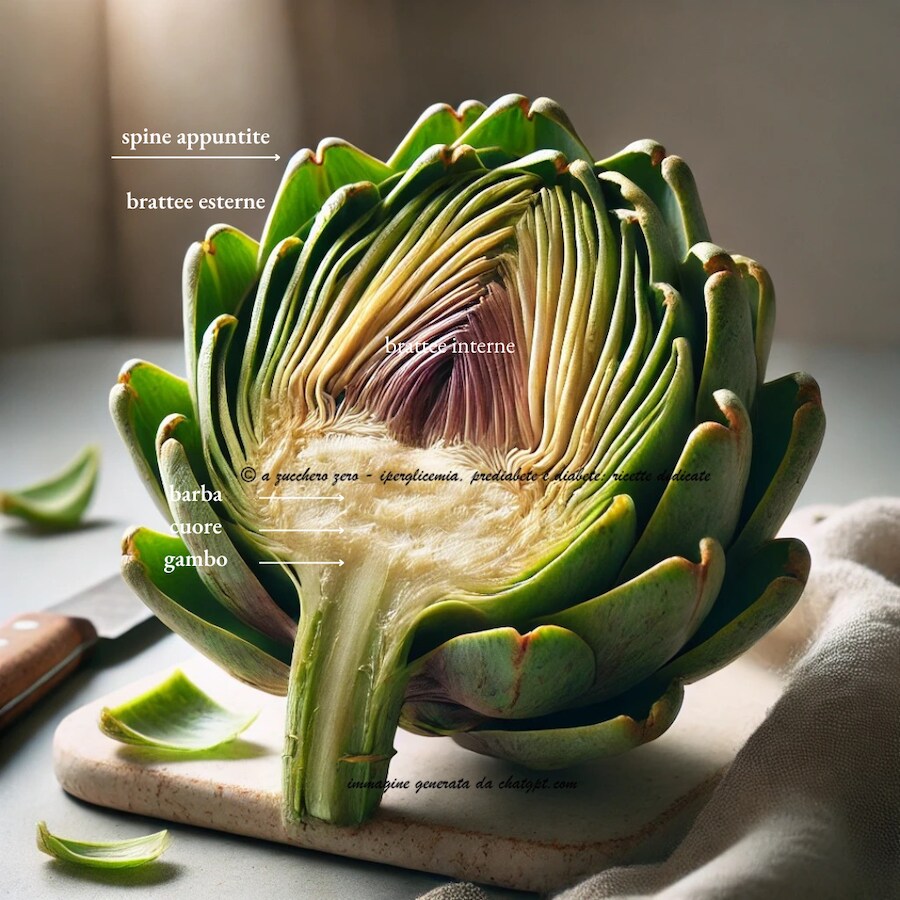
Clean and thoroughly wash the vegetables:
• shallot or onion;
• celery stalks and leaves.Cut the shallot or onion in half or quarters.
Cut the celery stalks into chunks and separate the leaves.In a sauté pan, add:
• the artichokes or the still frozen artichokes;
• a pinch of salt;
• lemon juice;
• 6.8 tablespoons of water;
and cook, covered and on high heat for 5 minutes.Add:
• shallot;
• celery;
and cook, covered and on low heat for 5 minutes.Off the heat, add:
• a vegetable bouillon cube;
• the stewed fava beans;
and mix them in, the more you stir, the more the fava beans break apart.
Adjust salt and grind the pepper.Bring back to a boil.
Add the chopped parsley.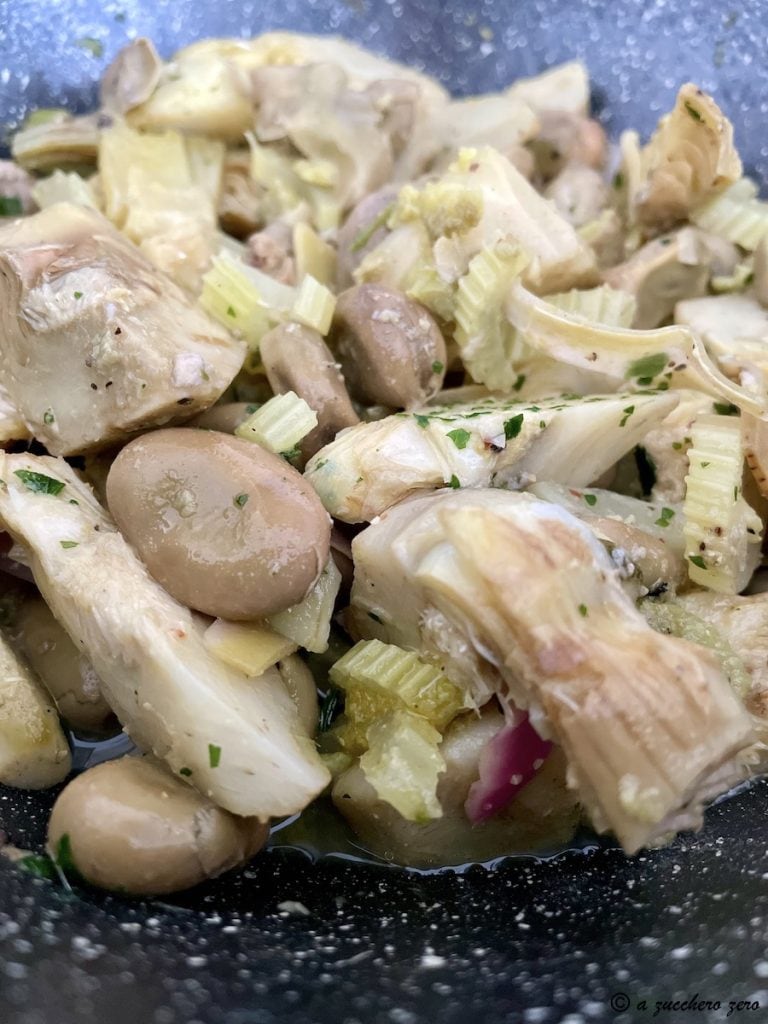
Plate it.
Grind a bit more pepper and drizzle with a trickle of extra virgin olive oil.Your vignarola with artichokes and fava beans is ready.
Enjoy your meal!
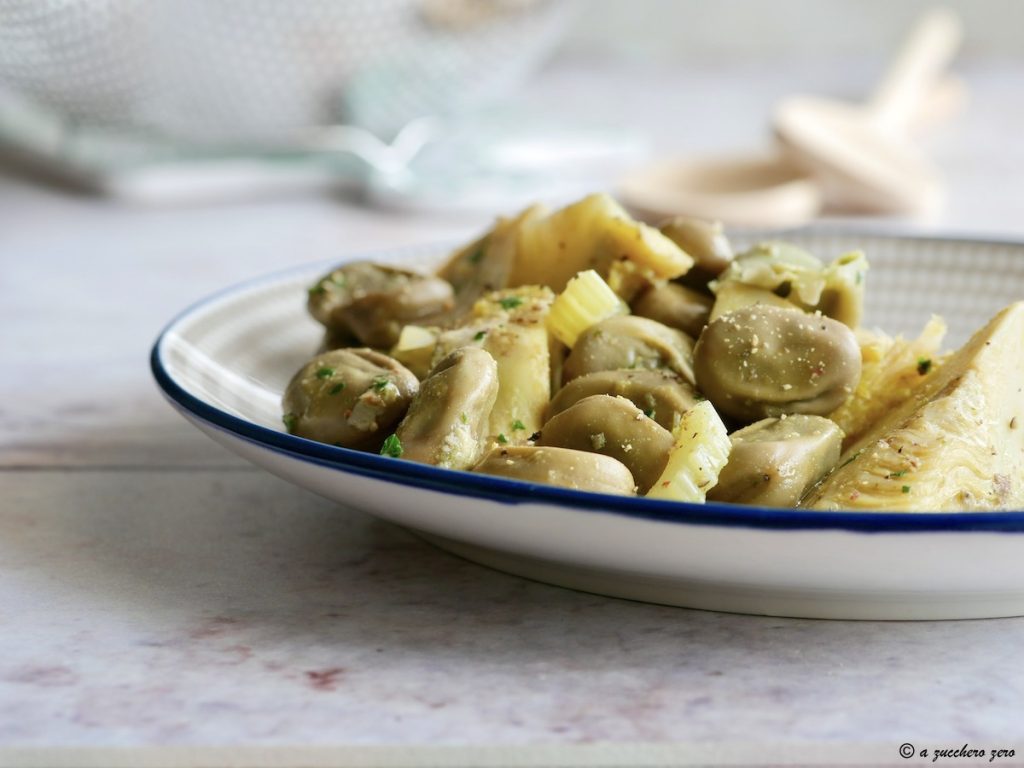
Advice on How to Combine Legumes
Combining with pasta, rice, or other grains allows for better absorption of the proteins in legumes.
The cereals included in these dishes, in fact, compensate for the amino acids lacking in legumes, allowing for a complete amino acid pool.
Preferably choose whole grains.
For more details: how to combine legumes in the diet.
FAQ (Frequently Asked Questions)
Can diabetics eat fava beans?
The glycemic index of fava beans [GI 40] is higher compared to other legumes and it increases with cooking.
In cases of hyperglycemia, prediabetes and diabetes cooked fava beans should be consumed in moderation [always according to your dietary plan, which includes them].
As Professor Enzo Bonora generally advises
In any case, in the presence of diabetes, it is essential to gain experience on the impact of this and all other foods on blood sugar. This means measuring it before and two hours after eating it. Preferably more than once for more reliable information. If the blood sugar increase is contained [under 50 mg] you can give a “green light” to that type of food. Otherwise, it’s better to avoid it.How to make fava beans more digestible?
It is better to use small and tender fava beans so that the skin is pleasant to eat; otherwise, in the case of large and tough fava beans, remove the skin if it is too fibrous.

